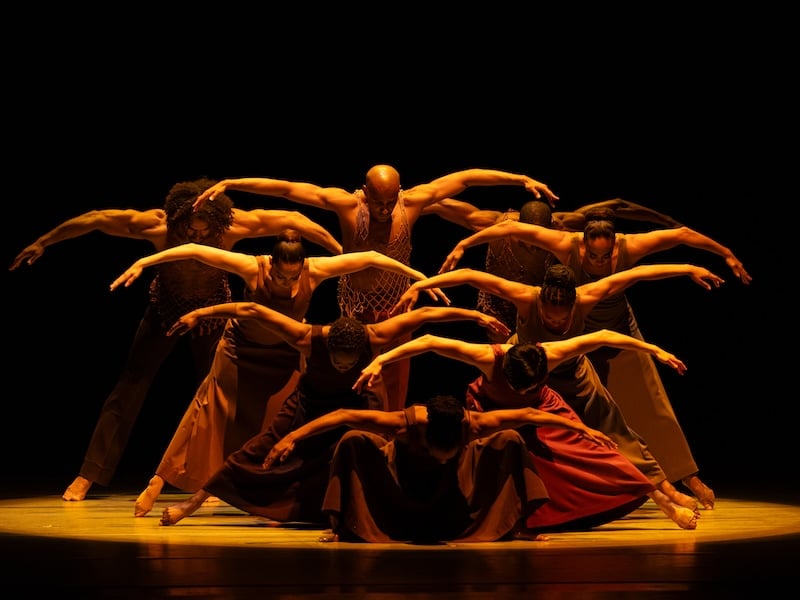Long before the words diversity, equity, and inclusion were ever uttered in a single breath, beloved choreographer Alvin Ailey was building a dance company that would look like 21st-century America. Born poor to a single mother in Texas, Ailey discovered dance as a teenager and went on to choreograph some of the most emblematic works reflecting African American stories and history. But when he founded his company in 1962, he emphasized that he never wanted a company of only Black dancers like himself. Even at its creation, Ailey was intent on building a troupe that reflected the multicultural ethos of the U.S. in ways that he had yet to fully experience at that time.
This week, DEI became embattled as the Trump Administration went on a witch hunt to eradicate programs at Federal agencies across the board. That made the return of Alvin Ailey American Dance Theater to the Kennedy Center Opera House a balm for both spirit and soul. This powerhouse influential company has a long special connection to the Kennedy Center. In fact, it was Ailey’s choreography and dancers that opened the Kennedy Center in the fall of 1971, performing in Leonard Bernstein’s premiere of his ambitious Mass.

Since then, the company has made the Kennedy Center a nearly annual stop on its busy national tour schedule. For the past quarter century, a post-performance gala has raised millions of dollars for the company. On Wednesday, February 5, Sela Thompson Collins, a gala co-chair, announced that a record $1.2 million was raised for educational programming, scholarships, and new works.
This run introduced four season world premieres, and every performance concluded with Ailey’s signature piece, “Revelations,” which brought the audience into an ecstatic frenzy. The cheers at the first hums and strains of the gospel-sung score shook the Opera House with the same energy as fans at Nationals Park.
“Revelations,” which traces the African American journey from enslavement to a cleansing baptismal to a joyous church celebration, draws on what the choreographer — who was all of 29 when he crafted the work in 1960 — called his “blood memories” of growing up in rural Texas in the Black Baptist Church. It became the inspiration for the most-anticipated premiere, “Sacred Songs,” created by Matthew Rushing, a company member since 1992, most recently interim artistic director.
Rushing returned to the roots of “Revelations,” which originally was about an hour long. But for a U.S. State Department tour, Ailey shortened the piece, cutting nine songs from his original choreography. Rushing, working with composer and former Urban Bush Women dancer Du’Bois A’keen, returned to these songs, some well-known like “By the Waters (of Babylon)” and “Glory, Glory),” others more obscure. The new settings shy away from the traditional gospel sounds of Brother John Sellers and Ella Jenkins, leaning further into jazz and rock influences and sounding more like 21st-century pop-infused church music.

Rushing’s approach to movement favors a less chiseled physicality than Ailey, a breathiness in the attack that lends a sense of freedom to the dancers from core to flowing limbs. He also emphasizes arms, sometimes in semaphores that converse with the defined angularity of dancers’ arms in “Revelations.” There’s the preacher’s point, prayer hands, the archetypal reaching upward and outward — expressing in gesture that search for freedom of body and spirit — and a two-handed flutter held close to the body, a motif that appears throughout “Sacred Songs.” For those who have “Revelations” etched into their soul — I’ve seen it likely 75 or more times over the past 40 years — Rushing tucks in some subtle choreographic quotes, legible for those familiar with the work. Attractive cream and gray loose-fitting casual tunics designed by Dante Baylor change in intensity from the etched rays of light by Andre Vazquez. The work plays with the individual and group in dynamic ways, yet the meandering shifts from one song passage to the next left multiple empty spaces that felt like false endings. Ultimately, the final imagery of “Sacred Songs” leaves viewers with an apotheosis of sorts, as the dancers on their knees circle around a heavenly glow of light that brings a sense of closure to the changing groupings.
The spiritual trope continued with “Many Angels,” by 81-year-old choreographer Lar Lubovitch, who has been a mainstay in the modern dance world for generations. In the work, set to Gustav Mahler’s Symphony No. 5, the choreographer said he reflected on St. Thomas Aquinas’ unanswerable question, “How many angels can dance on the head of a pin?” Performing before a gorgeous projection of heavenly clouds, the five dancers move with the ease and grace of 15th-century Italian master painter Botticelli’s angels. Lubovitch draws on the classical underpinnings of ballet with elegant arabesques, supported lifts, and sweeping turns. The five dancers even tumble gorgeously clad in diaphanous sheer jumpsuits over leotards. Lubovitch has given the company a Renaissance painting in motion. A skilled dancemaker, he excels at making beautiful work, but without shading, “Many Angels” lacks depth.
Hope Boykin performed with the Ailey company for two decades and has now stepped fully into choreography. Her “Finding Free” lives in shadows beneath overcast lighting. The ten dancers wear armor-like, stiff-collared jackets at first while struggling through push and pull, weighted stances, and sharp elbows. Deep thumping bass melds into rock-like riffs and drums from Matthew Whitaker’s score. This is a journey piece, but to where? A sense of dystopian disconnect sets everyone on their own exodus. When they come together, in a circle or a diagonal formation before peeling off again, a sense of common ground adheres. The work also pits the individual against the group as a sense of severity or precarity pervades. Soloist Jessica Amber Pinkett takes center stage, at times seated cross-legged like a high priestess or centered in a circle of fellow dancers. At one point, braided ropes pull against her from off-stage as she struggles until they slacken. When the mood lightens, with churchier music and brighter light, the dancers join in a unified rhythm, traveling upstage, disappearing into a black void. “Finding Free” aligns with the Aileyesque ethos in its individual-versus-society theme, its weighty movement motifs, and the abstracted portrait of humanity’s innate battle against adversity.
Another former Ailey dancer, Jamar Roberts, most recently served as the company’s resident choreographer from 2019–22. His premiere for the company, “Al-Andalus Blues,” features a flamenco-infused score performed by Roberta Flack and Miles Davis with a cantoara singing “Angelitos Negros” along with hints of flamenco dance, from sturdy, deep lunges to elegant curling hand flourishes. The curtain rises with a group of dancers, swathed in sleek black unitards with raised epaulets emphasizing shoulders. They stand poised on a grassy-colored slab. Leaving the promontory, they push away the sections until a lone dancer steps away, and the land-like mass is gone, suggesting a people who have lost their land. Moments of sparring, a few shouted yips, and some flat-footed stomps emphasize the nod to flamenco’s Andalucían roots. “Al-Andalus Blues” reflects many Ailey company works that draw inspiration from and pay homage to cultures across America, from jazz, blues, and hip-hop to African and the Mediterranean, especially Ailey’s own “Night Creature” and “Blues Suite.”
Across the decades, the annual Ailey run at the Kennedy Center brings tremendous joy to the always enthusiastic audiences who often clap and holler for an extended balance, a superb leap, or a whip-smart series of turns. But nothing garners more applause than the requisite company finale, “Revelations.” And at this moment, when our national values and democracy itself are threatened by POTUS and his administrative henchmen/women, the Ailey company is not merely a salve for the demoralized and depressed. In fact, it does not feel like an accident that POTUS chose the week Ailey company is back in Washington, DC, to depose, via a tweet, the president and key board members of the Kennedy Center and declare himself new president. Ailey, who passed away in 1989, built a company that has survived and thrived for nearly 65 years by dint of hard labor, dedication to the deeply embedded American values of diversity and equality, and the support of a vast constituency that returns year after year. The response and dedication are not just for the excellence the company exhibits on stage. The Ailey company is beloved because it shows us — viscerally, kinesthetically — who we are as Americans. We are strong, invincible, love beauty, truth, freedom and equality; and we acknowledge the “blood memories” that shaped our nation’s past are truly past as we place our hope in a better future.
Running Time: Approximately two hours and 15 minutes, with two intermissions. Varies by program.
Alvin Ailey American Dance Theater performs through February 9, 2025, in the Opera House at The Kennedy Center for the Performing Arts, 2700 F St NW, Washington, DC. Purchase tickets ($50–$202) online or by calling (202) 467-4600 or toll-free at (800) 444-1324. Box office hours are Monday-Saturday, 10 am-9 pm, and Sunday 12 pm-9 pm.
The program for Alvin Ailey American Dance Theater is online here.
COVID Safety: Masks are optional in all Kennedy Center spaces for visitors and staff. If you prefer to wear a mask, you are welcome to do so. See Kennedy Center’s complete COVID Safety Plan here.



